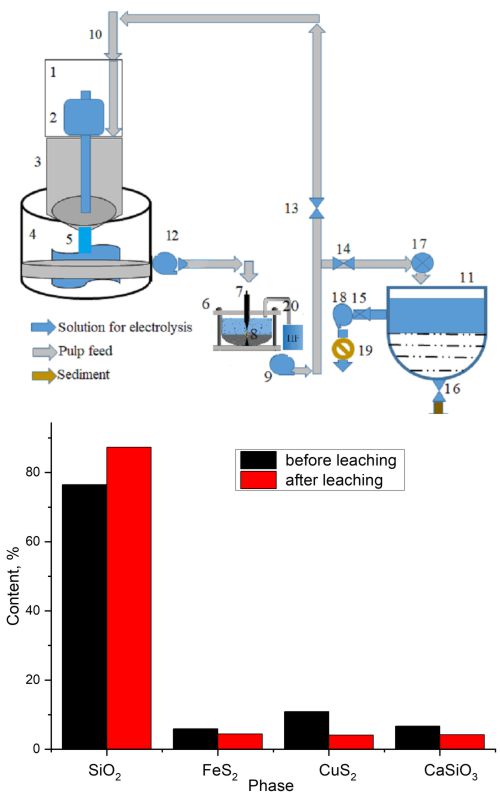A Study of copper leaching from the tailings of the Karagaily (Republic of Kazakhstan) concentrating factory using an electric hydropulse discharge Scientific paper
Main Article Content
Abstract
The method for using concentration plants tailings is proposed for the first time in this study. These tailings contain a number of valuable metals, such as Cu, Fe, Zn, etc., and are a potential raw material for obtaining concentrates of some elements. An electrohydropulse discharge was used to intensify the process of copper leaching and other metals. Ammonium bifluoride, the most effective of the ammonium salts used in copper leaching by the ammonization method, was chosen as the reagent. The influences of significant leaching parameters were studied and optimized using probabilistic deterministic planning of experiment. Based on the study findings, the following process conditions were found to be optimal: mass ratio of solid to liquid (S:L) of 1:1; Cu:F = 1:6; sulphuric acid concentration 40 g L-1; experiment duration 30 min; discharge voltage 10 kV and a leaching efficiency of 80‑85 % could be achieved. Comparative features of tailings samples from the Karagaily (Republic of Kazakhstan) concentration plant were studied using X-ray diffraction (XRD), scanning electron microscope (SEM) and atomic emission spectral analysis. The study results showed that copper was maximally transferred to the aqueous phase.
Downloads
Metrics
Article Details

This work is licensed under a Creative Commons Attribution-NonCommercial-NoDerivatives 4.0 International License.

Authors retain copyright and grant the journal right of first publication with the work simultaneously licensed under a Creative Commons Attribution license 4.0 that allows others to share the work with an acknowledgement of the work's authorship and initial publication in this journal.
References
I. V. Ukraintsev, V. S. Trubilov, A. S. Klepikov, Non-ferrousMetals 10 (2016) 27 (https://doi.org/10.17580/tsm.2016.10.05) in Russian
L. Sinclair, J. Thompson, Hydrometallurgy 157 (2015) 306 (https://doi.org/10.1016/j.hydromet.2015.08.022)
M. Sokovć, N. Radonijević, B. Marković, J. Stojanović, Z. Kamberović, N. Petronijević, S. Stanković, Hem. Ind. 73 (2019) 115 (https://doi.org/10.2298/HEMIND181009010S)
M. M. Antonijević, M. D. Dimitrijević, Z. O. Stevanović, S. M. Šerbula, G. D. Bogdanović, J. Hazard. Mater. 158 (2008) 23 (https://doi.org/10.1016/j.jhazmat.2008.01.063)
K. Ochromowicz, M. Jeziorek, K. Wejman, Physicochem. Probl. Miner. Process. 50 (2014) 327 (https://doi.org/10.5277/ppmp140127)
A. A. Baba, M. K. Ghosh, S. R. Pradhan, D. S. Rao, A. Baral, F. A. Adekola, Trans. Nonferrous Met. Soc. China 24 (2014) 1587 (https://doi.org/10.1016/S1003-6326(14) 63229-5)
I. A. Varlamova, N. A. Churlyaeva, N. L. Kalugina, Kh. Ya. Girevaya, Modern Problems Sci. Educ. 1 (2015) 1161 (https://www.science-education.ru/pdf/2015/1/1268.pdf)
A. A. Goryachev, E. V. Chernousenko, S. S. Potapov, N. S. Tsvetov, D. V. Makarov, Metals 11 (2021) 422 (https://doi.org/10.3390/met11030422)
L. A. Yutkin, Electrohydraulic effect and its application in industry, Mechanical Engineering, Leningrad, 1986, p. 253 (https://www.twirpx.com/file/85915/)
V. P. Malyshev, Probabilistic-deterministic planning of the experiment, The science, Alma-Ata, 1981, p. 116 (https://search.rsl.ru/ru/record/01001059848)
E. G. Rakov, Ammonium fluorides, VINITI, Moscow, 1988, p. 154 (https://www.twirpx.com/file/561942/)
M. A. Medkov, G .F. Krysenko, D. G. Epov, Far Eastern Branch RAS 5 (2011) 60 (https://cyberleninka.ru/article/n/gidrodiftorid-ammoniya-perspektivnyy-reagent-dlya-kompleksnoy-pererabotki-mineralnogo-syrya) in Russian
L. P. Demyanova, A. S. Buinovskiy, V. S. Rimkevich, Yu. N. Malovitskiy, Bull. TPU 317 (2010) 77 (https://cyberleninka.ru/article/n/ratsionalnaya-pererabotka-kvartssoderzhaschego-syrya-ftoridnym-sposobom) in Russian
R. I. Kraydenko, PhD Thesis, Tomsk Polytechnic University, Tomsk, 2008, p. 34 (http://earchive.tpu.ru/handle/11683/6398)
N. G. Klyuchnikov, Inorganic Synthesis Guide, Khimiya, Moscow, 1965, p. 373 (http://chemteq.ru/library/inorganic/2027.html)
B. Morosin, Acta Cryst. 25 (1969) 19 (https://doi.org/10.1107/S0567740869001725)
K. Nakamoto, IR Spectra of inorganic and coordination compounds, Mir, Moscow, 1991, p. 536 (https://www.twirpx.com/file/56977/)
I. I. Plyusnina, Infrared spectra of minerals, Publishing House of Moscow University, Moscow, 1976, p. 175 (https://www.twirpx.com/file/2096078/)
New methods of metal extraction, M. J. Collie, Ed., Metallurgy, Moscow, 1987
V. A. Andreev, A. S. Buinovskiy, A. A. Andreev, A. N. Dyachenko, Bull. TPU 311 (2007) 30 (http://earchive.tpu.ru/handle/11683/1788).





